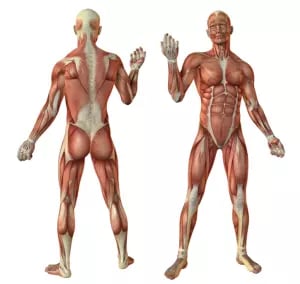How to Avoid Catabolism: Tips for Muscle Maintenance and Growth
Maintaining muscle is a key goal for anyone working toward fitness, whether through strength training, bodyweight workouts, or general physical activity. One of the major hurdles in muscle maintenance is avoiding catabolism—the process where your body breaks down muscle tissue for energy, which can happen when the body doesn't get enough nutrients or when it's put under excessive stress. Understanding how to minimize or prevent catabolism can make a huge difference in your fitness journey. Here’s how you can keep your hard-earned muscle intact and promote a body that stays strong and functional.
MEN'S HEALTH
11/4/20243 min read


1. Get Enough Protein
Why: Protein is essential for muscle repair and growth. When protein intake is insufficient, the body may begin to break down muscle tissue to meet its energy needs, leading to catabolism.
How Much: Aim for around 1.2 to 2.2 grams of protein per kilogram of body weight, depending on your activity level. Individuals who engage in intense physical activities often require the higher end of this range.
Sources: High-quality protein sources include lean meats, fish, eggs, dairy products, legumes, and protein supplements if needed.
2. Eat Enough Calories
Why: Caloric restriction can lead to muscle loss, especially if you're in a severe calorie deficit. Without enough energy, the body begins to use muscle protein as an energy source, triggering catabolism.
Balance is Key: You don’t need to overeat but focus on a slight caloric surplus or, if trying to lose weight, avoid drastic calorie cuts. Ensure you’re fueling your body adequately for muscle maintenance.
Track Your Intake: Use a calorie-tracking app or consult with a nutritionist to ensure you're meeting your calorie needs based on your goals and physical activity.
3. Time Your Nutrient Intake Properly
Pre-Workout: Eat a balanced meal with protein and carbohydrates 1–3 hours before exercise. This fuels your body and provides the necessary amino acids to prevent muscle breakdown.
Post-Workout: Have a meal or shake containing both protein and carbs within an hour of finishing your workout. This helps replenish glycogen stores and provides the muscles with the nutrients needed for repair.
Casein Before Bed: Consuming a slow-digesting protein like casein (found in dairy products or as a supplement) before bed can help maintain a steady supply of amino acids through the night.
4. Stay Hydrated
Why: Dehydration can stress the body, leading to increased cortisol levels—a hormone linked to muscle breakdown. Additionally, adequate hydration helps optimize nutrient transport, making it easier for muscles to receive the amino acids needed for repair and growth.
How Much: Aim for at least 3 liters (13 cups) of water per day, adjusting based on your activity level and environment. Hydration needs can vary, but ensuring you drink consistently throughout the day is essential for muscle maintenance.
5. Reduce Stress
Why: Chronic stress increases cortisol levels, which can accelerate muscle breakdown. Stress also makes it harder for the body to focus on muscle repair, slowing down your progress.
How to Manage Stress: Incorporate mindfulness practices like meditation or yoga, prioritize quality sleep, and engage in activities that help you relax. Exercise itself can reduce stress, but finding balance is crucial; excessive workouts without rest may raise cortisol levels.
6. Sleep Well
Why: Sleep is when most muscle recovery and growth occur. Lack of sleep increases cortisol levels and limits muscle protein synthesis, leading to muscle loss.
How Much: Aim for 7–9 hours of quality sleep each night. Good sleep hygiene, like having a consistent bedtime, reducing screen time before bed, and creating a relaxing environment, can improve sleep quality.
Naps: A short nap of 20–30 minutes can help improve recovery if you have trouble getting a full night's sleep.
7. Avoid Excessive Cardio
Why: While cardio is excellent for cardiovascular health and fat loss, too much of it can lead to muscle breakdown, especially if not accompanied by strength training.
Find Balance: Include cardio in your routine but avoid excessive, high-intensity sessions that could lead to catabolism. Low-impact exercises like walking, cycling, or moderate-intensity sessions can provide cardiovascular benefits without excessive muscle breakdown.
8. Incorporate Resistance Training Regularly
Why: Resistance training is the most effective way to signal your body to maintain and build muscle. It provides the necessary stimulus for muscle growth and prevents the body from breaking down muscle tissue.
What to Do: Focus on compound movements that target multiple muscle groups, like squats, deadlifts, push-ups, and pull-ups. Train each muscle group at least once a week, with a focus on progressive overload (gradually increasing the weight, reps, or intensity over time).
9. Supplement Wisely
BCAAs (Branched-Chain Amino Acids): If you train fasted or for extended periods, BCAAs can provide an immediate supply of amino acids to prevent muscle breakdown.
Whey Protein: Quick to digest, whey protein can be effective post-workout or as a convenient source of protein throughout the day.
Creatine: Known to enhance muscle recovery, strength, and endurance, creatine can support muscle maintenance during intense workouts.
Final Thoughts
Avoiding catabolism is about maintaining a balance between providing your body with enough nutrients, managing stress levels, and ensuring adequate recovery. By following these tips—prioritizing protein intake, staying hydrated, timing your meals well, getting sufficient sleep, and incorporating both resistance training and moderate cardio—you can protect your muscles from unnecessary breakdown and support your journey to a stronger, healthier physique.
Focus on consistency, listen to your body, and make adjustments based on your results and how you feel.
Follow us on social media
Explore fitness articles and personal training options.
Fitness Jobs
© 2024. All rights reserved.
